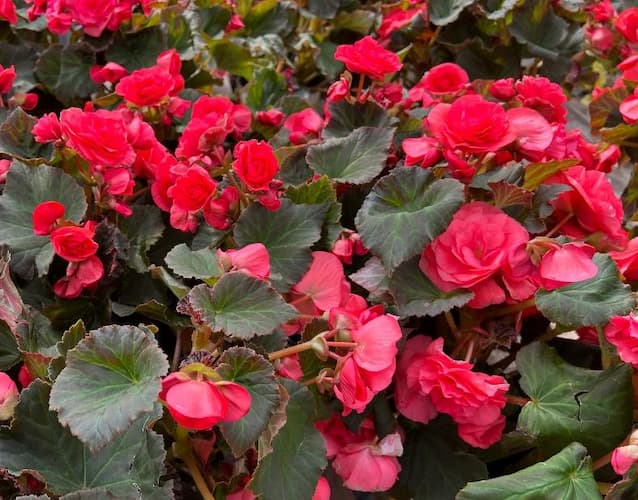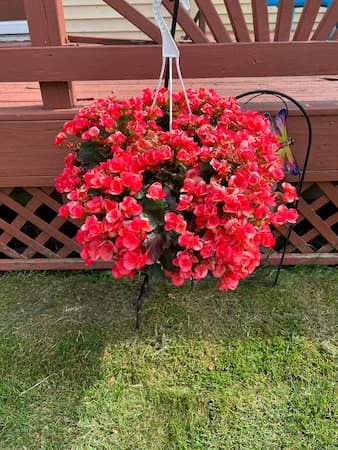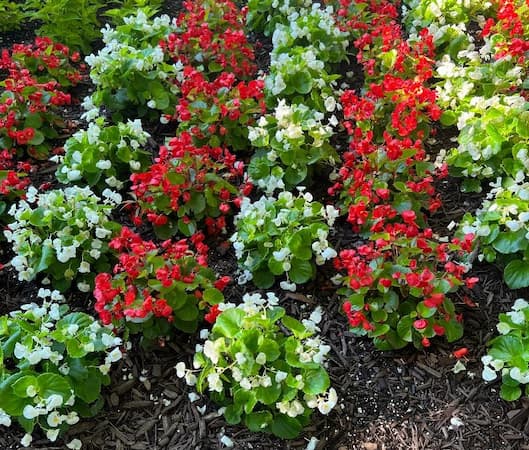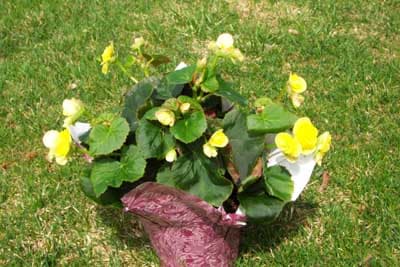How to Grow Begonia Flowers

Growing Begonia Flowers in Your Home Garden
Now here’s one of America’s favorite flowers. Growing Begonia flowers is easy. With lots of varieties, perennial Begonias are popular in flowerbeds, hanging baskets, container plants, and indoor houseplants. That’s one versatile plant! Use this guide to learn how to grow begonias. Then, acquire some Begonia seeds or plants and get growing.
Begonia plants are native to Central and South America.
Begonias are prized equally for their flower, as well as their showy leaves. When they are not in bloom, which is infrequent once established, their attractive, waxy green or chocolate-colored leaves show themselves off wherever you have placed them.
Growing begonias indoors is popular, too. They make good indoor houseplants as they tolerate shade well.
Number of Varieties: over 6,000!

Types of Begonia Flowers
There are three types of Begonias: Tuberous, Semperflorens, and the uncommon Perennials. The Semperflorens are by far the most common. They include Fibrous Begonias, Wax Begonias, and Everblooming Begonias.
Depending upon the type, you can find red, white, pink, or yellow varieties. All flowers have a bright yellow eye(center).
All varieties will grow compact, dense foliage, and grow about 6-9 inches tall.
Begonia Plant Specifications
Flower Colors: Orange, pink, red, white, and yellow.
Flowers Bloom: Summer to Fall. Indoors, any time of year.
Plant height: Six to nine inches.
Light Requirements: Partial sun to light shade.
Ideal Soil pH: 6.0 – 8.0.
Hardiness Zone: 9 – 10
Toxicity: Roots are toxic. Other parts of the plant are edible.
Native To: North and South America and Southern Europe.
Plant Type: Perennial, in northern areas, sometimes grown outdoors as an annual.
Botanical Name: Begoniaceae

Are Begonia Flowers Edible?
Yes!
The leaves, flowers and stems of strawberry, tuberous, and wax varieties of begonias are edible. They are crispy with a citrus-like and slightly bitter taste. Try them in salads or mixed with vegetables.
The roots of the plant are mildly toxic.
Begonia Plant Medicinal Uses
It is used as a laxative to relieve constipation, empty the bowels and for bowel health.
A medicine made from it induces vomiting, for use in cases of poisoning.
Also, it is rich in vitamin C.

Begonia Plant Propagation
Begonias are propagated from seed or cuttings. Begonia seeds are very fine, dust-like, and take two to three weeks to germinate. Many people will buy seedlings rather than try to start these tiny seeds. Cuttings are much easier if you want to propagate a few plants and already have one.
Tuberous varieties are commonly propagated by separating and replanting the tuberous roots.

How to Grow Begonias Flower Plants
Begonia flowers are annuals and do not like frost in the spring or fall. Set them out in containers, hanging baskets, or your flowerbed after all risk of frost has passed.
Begonias thrive in a range of sunlight from full sun to shade.
They like rich, loose, and fertile soil that drains well. Water thoroughly, then allow the soil to dry before the next watering.
Begonias like attention. Remove dead flowers, leaves, and stems. Trim off long stems to help retain their compact shape. A little care will pay you back with lusher foliage and more blooms.
Add a general-purpose fertilizer once a month. For houseplants and container plants, give them a dose of liquid fertilizer once a month instead of dry fertilizer.
You can harvest begonia seeds for planting next year. Harvest seed pods when they become dry and before they open and spill out the seeds. Remove them from the seed pods. Then, allow them to dry for a week before storing them for next year.
Insects and Plant Disease
There’s great news here! Your begonias should have few if any problems with insects or disease, indoors or out.
Also see: Plant Problems – causes and cures.

Bringing Perennial Begonias Indoors as Houseplants
Your Begonias can be brought indoors before frost. Remember, they will die in a light frost, so if one threatens your area, don’t wait!
Re-pot the plants if they appear crowded. Use rich potting soil. Help them in their transition indoors. When first brought inside, keep them near a sunny window, gradually, reducing the sunlight. This will help them to adjust indoors. Significant leaf drop is common at this point. But, in a week or two, they will be well acclimated to lower light levels and dry conditions in your home. They will brighten up your home all winter!
Related Articles
People who read this article on Begonia flowers also like:
Please support our site. Shop for:
- rmmatthews100@hotmail.com
- 585-721-6528
- Rochester, NY
©1999-2024 GardenersNet.Com, All Rights Reserved

